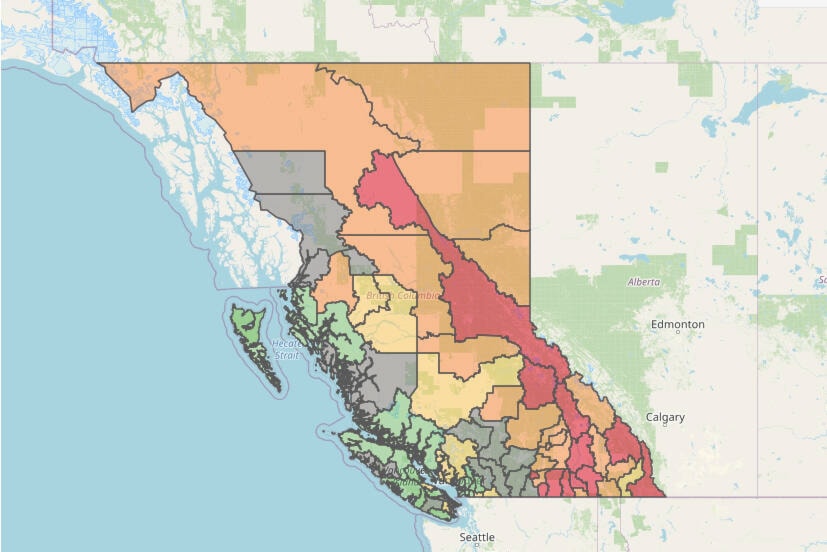A new interactive map is being used to highlight the dangers of indoor radon in B.C. homes.
The tool was launched by the BC Centre for Disease Control (BCCDC), and is based on tests from inside homes in communities around the province.
Long-term exposure to radon, especially at high levels, can cause lung cancer, the BCCDC said in a press release announcing the new tool. The risk of developing lung cancer due to radon is even higher for smokers. It is the leading cause of lung cancer for non-smokers, and the second leading cause for smokers.
“Radon gas exposure is one of the lesser known causes of lung cancer but is an important risk factor,” Dr. Parveen Bhatti, principal investigator in Cancer Epidemiology & Prevention at BC Cancer.
“This map allows British Columbians to see the proportion of homes in their community that are estimated to have high levels of radon, and what these levels of radon mean for their risk of lung cancer,” says Dr. Cheryl Young, senior Public Health and Preventive Medicine resident, Environmental Health, BCCDC. “With this information, British Columbians can make informed decisions about how to protect themselves against the effects of radon.”
Some of the communities with the highest rates of radon exposure are Summerland, Nelson, Trail, Revelstoke and Prince George. In the Lower Mainland, Chilliwack and Abbotsford have the highest ratings.
Search for your community .
Radon is a naturally occurring colourless, odourless, radioactive gas that is released when uranium breaks down in soils and rocks. BCCDC explained that it is a problem in indoor settings because it can build up and become a health risk. Radon can seep into homes through any opening that touches the ground. Radon levels are usually highest in the lowest levels of a building, such as the basement.
Radon levels within homes vary across the province because of regional differences in soil and rock. For example, homes in parts of Interior and Northern B.C. will have higher levels of radon than other parts of the province, so it is especially important for people living in these regions to test their home for radon.
“However, even in regions with generally low levels of radon, the amount of radon can vary from house to house,” says Dr. Young. “This is due to many factors including how the foundation of the home was built and how much ventilation occurs in the home. Because of these factors, the age of a house is not a useful factor in predicting the levels of radon within it.”
Radon testing is the only way to know the radon level in your home, the BCCDC advises. Testing is recommended for all homeowners, but especially those who live in areas with higher levels of radon and those who smoke. Testing can be done using a do-it-yourself kit or by hiring a professional certified by the Canadian National Radon Proficiency Program.
“For the most accurate reading of the radon level in your home, it is important to use a long-term test kit, which requires the device to be placed in the home for at least 90 days,” says Dr. Young. “This is because radon levels can vary greatly over time, even from day to day, so a short-term test kit that just gives a snapshot of the radon level might give a false low reading if it was taken during a brief time of lower radon levels.”
Radon is measured in Becquerels per cubic meter (Bq/m3). Health Canada recommends home improvements within two years when radon levels are above 200 Bq/m3, and within one year when the levels are above 600 Bq/m3, though homeowners may choose to improve their home at any level to reduce their risk of lung cancer.
“There are a few ways to reduce the amount of radon in your home. Simple solutions, such as sealing the cracks in your basement floors, can help reduce how much radon seeps into your home, but if your home has a high level of radon, an exhaust system can be installed that is very effective at lowering the amount of radon in your home,” says Dr. Young.
A professional certified by the Canadian National Radon Proficiency Program (C-NRPP) can help homeowners evaluate options and choose the most appropriate one for their home. Even for homes with lower levels of radon, some simple measures may help to reduce concentrations even further.
More information about radon testing, mitigation and health risks can be found on the BCCDC website: .
READ MORE:
READ MORE:
jessica.peters@hopestandard.com
Like us on and follow us on .
Want to support local journalism during the pandemic? Make a donation



